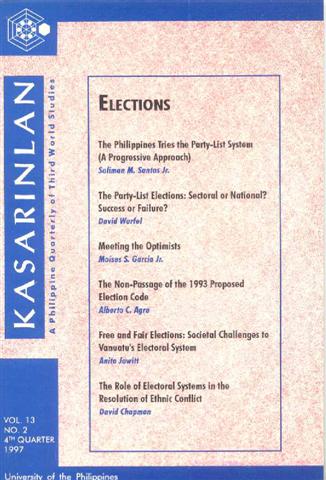The Role of Electoral Systems in the Resolution of Ethnic Conflict
Abstract
The difficulty of establishing democracy in ethnically divided countries can be traced to the tendency of parties to divide on ethnic lines, and to become more or less mono-ethnic. To overcome this problem, a range of eleven new electoral systems is put forward, designed to provide each party with strong electoral incentives to become pan-ethnic, that is, to seek the votes of each ethnic group, and to respond to the concerns of each ethnic group. Each new system is a modified form of proportional representation, which allocates one-half of the seats in proportion to each party's first-preference votes, as a guaranteed minimum, and allocates the remaining half of the seats as a pan-ethnic incentive, to reward parties for obtaining votes from each ethnic group. Each new system uses, to provide this pan-ethnic incentive, one or both of the following two basic principles: Two-Party Competition and the Distributed Vote. Systems using the first principle set up any number of two-party competitions, in each of which the two parties compete for the votes of the whole electorate. A party gets more seats not only by getting more first-preference votes, but also by getting a higher non-first ranking from electors who give their first preferences to some other party. This gives the party the incentive to appeal more widely, to electors of ethnic groups and other groups to which it did not appeal before, in order to obtain a higher non-first ranking from them. Systems using the Distributed Vote operate by rewarding a party with more seats for getting an even distribution of its votes between the different ethnic groups. Should a system become acceptable, the dominant parties will share their influence with the previously excluded minority, resulting in a more stable and peaceful political system.
Published
2007-10-10
How to Cite
CHAPMAN, David.
The Role of Electoral Systems in the Resolution of Ethnic Conflict.
Kasarinlan: Philippine Journal of Third World Studies, [S.l.], v. 13, n. 2, p. 91-118, oct. 2007.
ISSN 2012-080X.
Available at: <https://journals.upd.edu.ph/index.php/kasarinlan/article/view/325>. Date accessed: 28 aug. 2025.
Section
Features
Keywords
electoral system; ethnic conflict
By submitting a manuscript, the authors agree that the exclusive rights to reproduce and distribute the article have been given to the Third World Studies Center.



